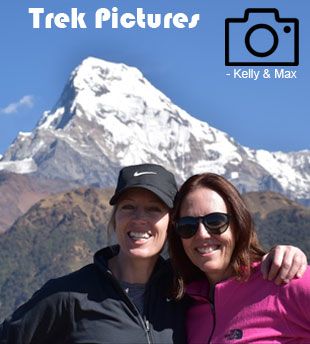- Home
- About us
- Nepal
- Tibet
- Bhutan
- Nepal Tour Packages
- Kathmandu Tour
- Nepal Tour 5 day
- Chitwan Pokhara Tour 8 day
- All Nepal Tour 12 day
- Nepal Driving Tour 12 day
- Family Tour in Nepal
- Nepal Tour Special 14 day
- Heritage Tour 14 day
- Art & Craft Tour
- Birding Tour in Nepal
- Lumbini Tour
- Honeymoon in Nepal
- Mustang Jeep Tour
- Tiji Festival Tour
- Wildlife safari Tour
- Hindu pilgrimage tour
- Buddhist Pilgrimage Tour
- Yoga Meditation Tour
- Volunteer Nepal
- Nepal Treks
- Tibet Tour Package
- Bhutan Tour Package
- Travel Tips
- Gallery
- Contact
- Blog
- XML
Must know tips for Annapurna Base Camp Trek
Annapurna base camp is a magical place in a high glacial basin at the altitude above 4,000 m, surrounded by snow peaks above 7,000 m. Easy access, moderately difficult trek, availability of teahouses, awe-inspiring view and cultural experiences make it the most popular trek in Nepal. We have been successfully organizing a trek to Annapurna base camp since 2011. Here are some of the must know tips for planning your trek to Annapurna base camp.
Best itinerary / route
Annapurna base camp trek could be done in as less as 6 days from Pokhara and back and within a week in Nepal. While the standard itinerary takes a detour of Ghorepani / Pun Hill, the short itinerary drives farther into the Modi River valley and only does the core part of the trek by escaping the foothills.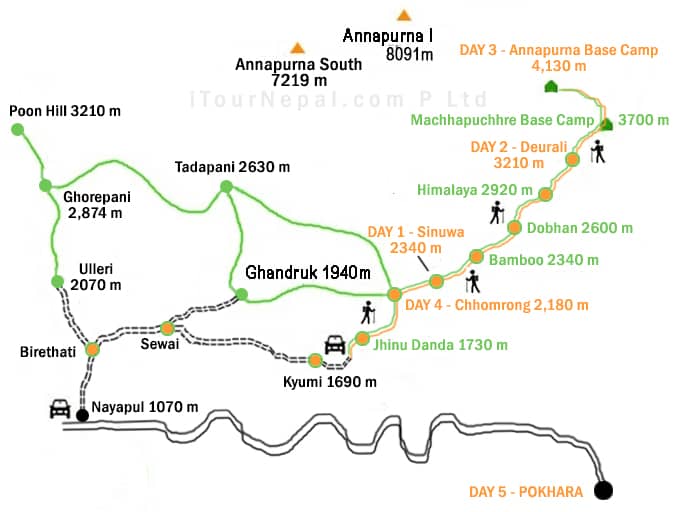
Standard itinerary
The standard itinerary follows the longer route via Ghorepani, coming to several viewpoints looking at over a dozen of peaks of Dhaulagiri and Annapurna ranges. The longer route also gives you more time to acclimatize and get used to the walking and the atmosphere.Short ABC Trek
Short ABC trek is for trekkers with sound fitness with previous experience. The route climbs steeply up and down above the altitude of 2,000 m. In a very short time, trekkers face sudden drop in temperature and also low oxygen. The itinerary is however designed to stay a few nights above 2,000 m and 3,000 m before reaching Annapurna base camp at 4,200 m.What not to miss:
The trek is not only about getting there but also about the journey. There are several viewpoints and charming villages along the way to visit for the best trek experience.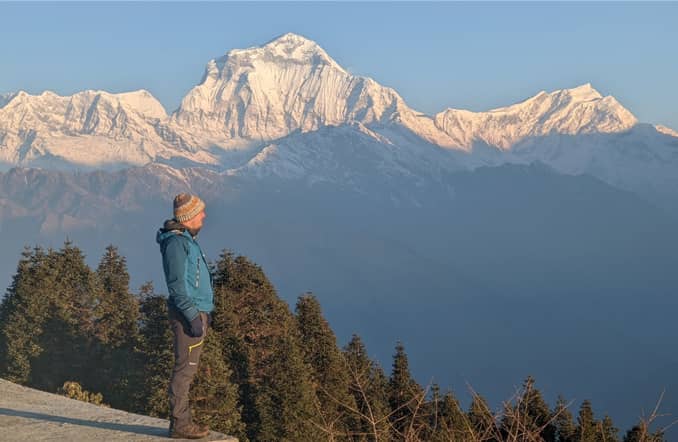
Ghorepani – Poon Hill :
Ghorepani is the most popular ridge top village at the altitude of 2,800 m overlooking the snow peaks of Dhaulagiri and Annapurna ranges. The sunrise or sunset hike to Poon Hill (3,200 m) gives a better view of the peaks.Chhomrong village:
The chhomrong village at 2,100 m is facing the Annapurna South, Hiunchuli and Mt Fishtail. The location has an up-close view of those peaks with different angles. This is the last permanent and big Gurung village on the way to base camp with provision store, health post and high school.Sunrise from Annapurna base camp :
The base camp is a glacial basin at 4,200 m looking at snow peaks at 360 degree. Annapurna I (8,091 m / 10th highest in the world) rising vertically from the top of the glacier dominates the northern view. The sight of the mountain turning from pink, red to orange with early rays of sun is a must to watch.Jhinu danda hot spring:
Ending a trek in Jhinu danda or having a rest day there will give you plenty of time to go and wallow in a natural hot spring. Bathing in hot springs is believed to naturally detox skin, heal muscle soreness and back pain.Train yourself to come mountain fit
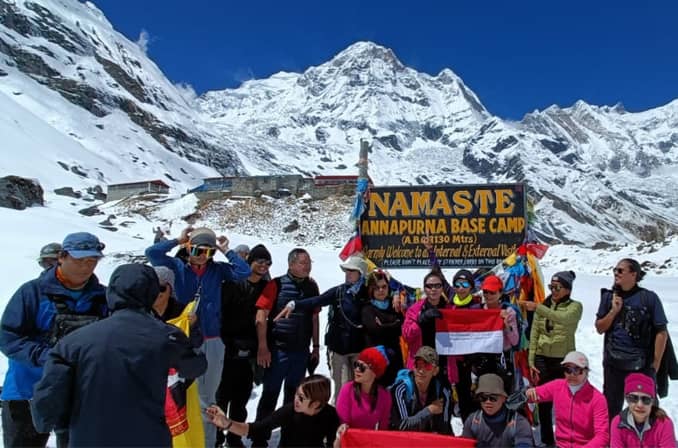
How difficult is the trek ?
Preparing yourself physically always enhances your trek experience. Annapurna base camp trek is moderately difficult by grading. The trail climbs up a mountain pass and down to the valley just to climb to the other side. Each up / down is about 500 m. There are thousands of stone steps and uneven, rugged, beaten trails that cross the rivers on suspension bridges and plank bridges. At higher altitude sections of trails may be covered in snow fields, rockery and scree deposited by avalanches.
How to train for the trek ?
Regular workout, jogging and hiking will help to increase your stamina and endurance to complete the trek in a fun way. Train yourself by walking up the mountain or on a stair-master at least two months before the trek. This is also good for breaking into your new equipment.
If you are jogging, using a treadmill or stair-master during the week, go on a real hike carrying 10 kg in a backpack for the weekend. Taste your stamina by climbing 600 m and do the downhill as well. If you don't have a mountain around you, go up and down the staircases or long hike carrying a backpack.Right gears and packing wisely
Choosing right gears depends upon the time of the year you are travelling. A pair of good trekking boots are a must as you will be walking about six hours a day for multiple days on rugged trails. Keeping yourself warm is another important thing. But the temperature fluctuates a lot throughout the day and throughout a trek. Best practice would be to dress in layers so you can peel off or put on layers according to temperature. A Gore tex jacket to go on the top of layers helps in case of rain or snow. With good layers you don't need a down jacket. If you are travelling between November to March, a down jacket will be helpful. You can also get one on rent in Kathmandu or Pokhara.
- You can walk in shorts or light full sleeve shirts and trousers during the day. Keep a warm fleece jacket or pullover handy, in a daypack to use when you stop for a long time.
- Travelling light makes it less stressful and easy at teahouses.
- You don't need sleeping bags as tea provides blankets. But a sleeping bag liner would be handy.
- Many trekkers wash and reuse their socks and shirts during the trek. You can dry them by the fire in the teahouse dining.
Nepal Trek Equipment & Gears
- Water bottle
- Flash light – At least one headlamp or torchlight will be handy.
- Personal towel
- Knife – multifunctional portable pocket knife
- Hand sanitizer and other toiletries
- Sun lotion
- Essential medicine & first-aid kit
- Ruck sack – 40 – 60 liter that can carry gears ranging from 15 – 20 kg.
- Daypack – 15 – 30 lt for you to carry, water and other essentials for a day.
- Sleeping bag - Light silk sleeping bag or liner as backup.
- Trekking shoes / boots - 1
- sleeper or camp shoes -1
- Shocks – 2 thick pairs to wear while sitting around at high altitude, 4 medium and thin pairs of socks for walking.
- Down jacket is required for the month of December – February and also for trek going above 3,500 m.
- Waterproof / windproof jacket with warm fleece inner will be enough for other months.
- Thermal under wares - 1
- Fleece jacket / jumper / pullover - 2
- Hiking pants
- Hiking shirts
- T-shirts
- Sun hat
- Gloves
- Trekking poles
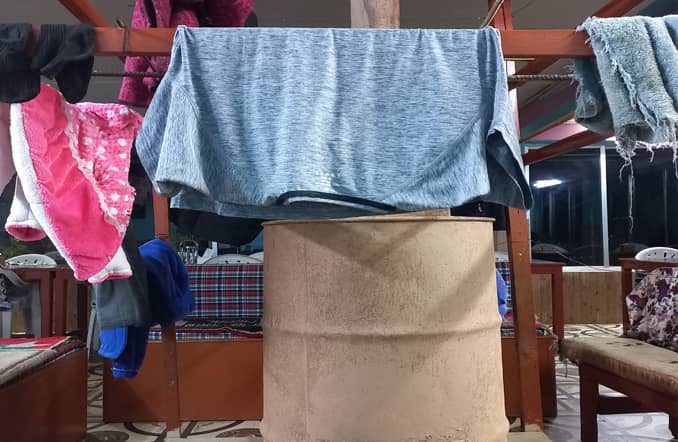
Get the necessary permits :
Solo trekking has been banned in Nepal from 1 April 2023. You will need two permits: the Annapurna Conservation Area Permit (ACAP) and the Trekker's Information Management System (TIMS) card. Now all trekkers have to book a trek through a registered trekking company. Hiring a guide and / or porter supports sustainable tourism, enhances your experience and makes the trek more comfortable, especially if you are new to trekking.Stay healthy in the trek
Avoid Altitude Sickness
The longer trek via Ghorepani allows trekkers to acclimatize better. Have flexible days in case. Plan a trek with a slow ascend above Himalaya (2,900 m). You don't need to spend an extra day at any places but go slow if you have any doubt. Spend one night at each place above Himalaya, i.e. Deurali, Machhapuchhre base camp before spending a night in Annapurna base camp. In the worst case you can also visit Annapurna base camp in the morning from Machhapuchhre base camp and head back.Symptoms and preventions : Familiarize yourself with the symptoms of altitude sickness, such as headache, nausea, and dizziness. If you experience severe symptoms, descend immediately. Drink at least 3 liter of water a day. A Diamox (Acetazolamide) (250 mg once a day) tablet could be taken 24 hours before arriving at high altitude as a precaution.
According to the exit poll at the Kathmandu airport, 68 % of the travelers experienced diarrhoea during their visit. The data shows about 60 % of cases during the warmer months (April - September) and only 40% cases during the trekking season.
Traveller's Diarrhoea
The most common diarrhoea (about 75 %) seen in travelers is known as 'Traveler's Diarrhoea' . Traveller's Diarrhoea is bacterial infections and are preventable and also easily treatable. It is characterized by sudden onset of uncomfortable diarrhoea (twice than normal), nausea and cramps. This could be resolved on its own without medication but it can cause dehydration, fatigue and delay your trekking plan.
Rehydration is a remedy of many altitude related problems including diarrhoea. Loparamide is popularly used medicine to treat the symptoms. Only in severe case, antibiotic is are recommended.
Sunburn
Don't underestimate sunburn even if you are used to the temperature and your skin complexion has better registrant. The altitude in the Himalayan trekking exposes you to more UV rays. A sunscreen of SPF 30 ( 97% effective against UVA) works for trekking in the Himalayas. Just make sure to apply it half an hour before starting your day and also to wash and reapply during the lunch breaks or as required. Cover ears and neck.Khumbu Cough
Dry persisting cough because of fastened breathing of cold and dry air at altitude is known as Khumbu cough. Wear buff, mask or handkerchief to breath in warm air, drink hot water and inhale steam, lozenge and cough syrup are helpful against the cough.
Blisters, snow blindness and sore knees
Other common health issues during the trek are blisters, snow blindness and sore knees. Make sure to break into your shoes before coming on a trek. Look for earlier sing of blisters and prevent it with tape or moleskin.Similarly the UV reflected by snow at high altitude may burn eyes known as 'snow blindness'. A good pair of sunglasses with UV protection is a must for the trek.
Most people hurt their knees while descending. You must descend carefully and not as fast as it is tempting.
Risk of avalanches in the Annapurna base camp trek
Trekkers should also be informed about the risk of avalanche in the Annapurna base camp trek. Even though relatively low, but there has be incidences of missing and stranded trekkers because of avalanches along the trek. Well marked trails, experienced guides and preventive measures taken is the cause of low risk. Just know these precautionary facts and you can simply enjoy the trek. The section of valley from Dovan to Machhaphuchhre base camp (MBC) has gullies which may downpour fresh snow in small or larger amount. The floodplain crossing from Hinku cave to Deurali is the toughest with eroding rockery and snow deposition from avalanches. The avalanches mostly happens after the rain / snow on the previous day or night. It mostly happens after around 11:00 am. Plan your itinerary in a way that you will cross the avalanche prone areas in the early morning. Don't wait or waste time in the middle of crossing a stream.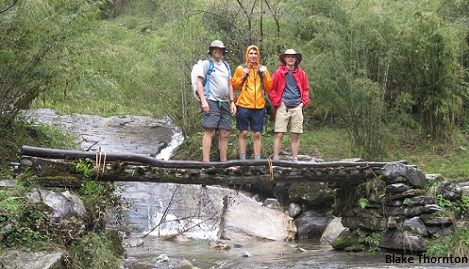
Be a responsible trekker :
Employ local guide / porter
Hiring guides and porters not only help you travel like locals but also give you a deeper insight of the place and culture.Stay in local teahouses or homestay
Teahouses and homestays are run by local families. There are also lodges available in some places. But staying in teahouses is an opportunity to experience local culture. This will also support the local economy and help to sustain the culture .Respect local culture
The locals of Annapurna are very friendly and hospitable. So they won't get offended by your mistake as a foreigner. But you can be an ideal tourist by respecting their culture. Take off shoes before entering homes, temples and monasteries. Get permission before taking pictures. Go clockwise around the sacred places like temples or Mane walls.Dispose trace
Carry out all your trash, including non-biodegradable items. Leave no trace and help preserve the natural beauty of the area. The shortest Annapurna base camp trek could be done in 5 days from Pokhara or Kathmandu. How safe is the short ABC trek ? A helicopter flight back from base camp makes it even shorter and more convenient.Speak with an Expert
The tips we have listed above are the most important information we consider while planning the Annapurna base camp trek for our clients. Talk with our expert to customize a socially responsible, culturally rich and ecologically safe trekking.
- Support local company.
- Expertise over 20 years.
- Cost effective Treks.
- Cultural immersion experience.
- High quality services.
- Eco friendly & sustainable practices.
ABC Trek Review
Amazing Experience
A solid 5* rating for i Tour Nepal. The team managed to put together and organise a trekking tour for us on very short notice (including flights, helicopter charter, guide and hotels). Everyone we met went the extra mile to make the trip a pleasant experience. The team speaks excellent English and we always felt well taken care of. We are already looking forward to our next trip to Nepal and will definitely pick i Tour Nepal again. - Arvardan - GermanyShort Everest Trek 8 days
If you are limited with time and still want to get the feel of Sherpa land, this trek is for you. Since the trek starts with flight to Lukla at 2,800 m, the trek avoids humid and hot climate of Summer. A short trek of 5 days could be planned based in comfortable Hotels (luxury trek).
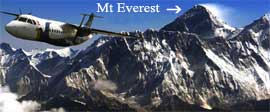
Everest sightseeing Flight
The 1 hr. fixed wing Himalayan sightseeing flight is the best way to see Mt Everest and other peaks east of Kathmandu.- Window Seat
- Everest View
- Airport

Only USD 500 !
Helicopter tour of
Annapurna Base Camp
Annapurna Heli Tour
Short treks in Nepal
The mountainous landscape of Nepal with Himalayan frontier provides perfect ground for dreamlike trekking. Check out other short treks in the Himalayas of Nepal.
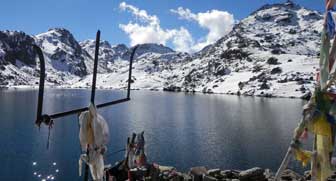
Nepal Pilgrimage Tour
Ancient pilgrimage redefined for cultural immersion experience and Himalayan scenery with discourse on spirituality and religious practices in the Himalayas.
Nepal walking Tour
Read More
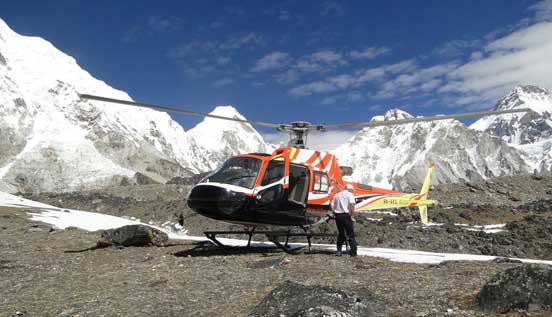
Best Way to see Mt Everest
Experiencing Everest could be a pleasant long lasting memory.- Nepal Trips for Winter
- A guide to explore Nepal, Tibet and Bhutan.
- Things to do in Lower Mustang
- Nepal Travel Tips for seniors
- 5 cultural immersion tour of Kathmandu
- 5 Most popular Tour of Nepal
- Best family holiday activities in Nepal
- Best way to see Mt Everest
- 5 easy treks in Nepal
- Short Trek from Pokhara
- Shortest Trek to Annapurna Base Camp
- Highlights of Mustang Tour
- Nepal, the best spiritual destination in the world
- All about Muktinath Tour
- 4 sightseeing around Lumbini
- Most popular Buddhist sites of Nepal
- Buddhist sites around Kathmandu





